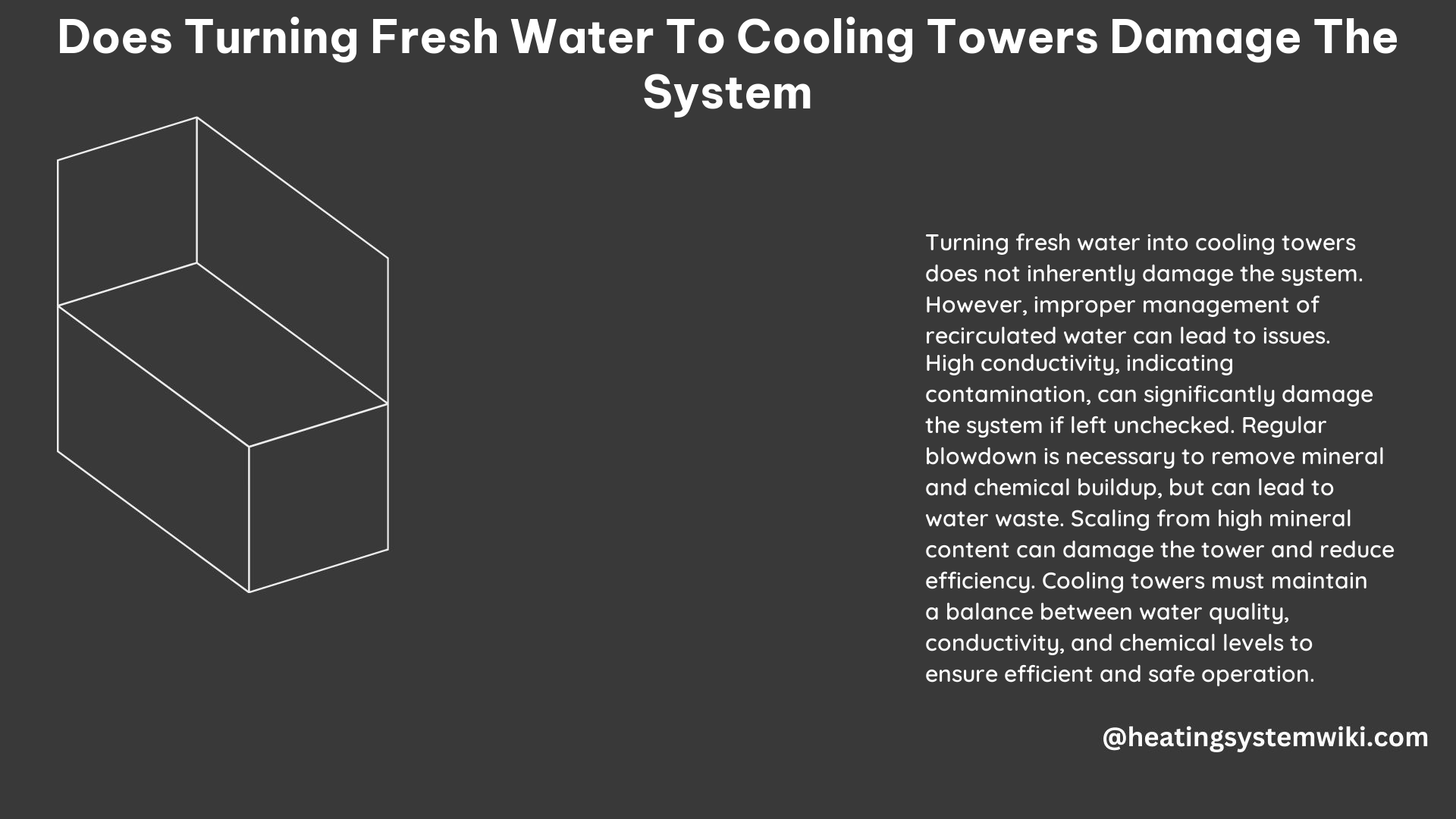Turning fresh water into cooling towers is a common practice in industrial processes and large buildings to remove waste heat and cool down equipment. However, there are potential issues that can arise from using fresh water in cooling towers, including high conductivity, corrosion, and biological contamination.
High Conductivity in Cooling Tower Water
High conductivity in cooling tower water can indicate that the water is contaminated and likely contains high levels of pollutants. This can damage the process and cooling systems if it goes above the maximum value on a continual basis. The acceptable range for conductivity in cooling tower water is typically between 1,000 to 2,500 μS/cm (microsiemens per centimeter), but values above 3,000 μS/cm can start to cause issues.
When conductivity levels are too high, it can lead to:
- Scaling and Fouling: High mineral content in the water can cause scale buildup on heat exchanger surfaces, reducing heat transfer efficiency and increasing pressure drop.
- Corrosion: Increased ionic concentration in the water can accelerate corrosion of metal components, leading to leaks and equipment failure.
- Biological Growth: High conductivity can promote the growth of algae, bacteria, and other microorganisms, further exacerbating fouling and corrosion problems.
- Increased Energy Consumption: Scaling and fouling caused by high conductivity can reduce the cooling tower’s efficiency, leading to higher energy consumption to maintain the desired cooling capacity.
To monitor and control high conductivity, cooling tower operators should regularly test the water and implement appropriate water treatment strategies, such as blowdown, chemical treatment, or the use of reverse osmosis or ion exchange systems.
Corrosion in Cooling Towers

Corrosion is a common problem in cooling towers, as the water can cause metal components to corrode when it comes into direct contact with them. This can lead to:
- Damaged Equipment: Corroded metal parts can fail, leading to leaks, reduced efficiency, and potential equipment breakdowns.
- Debris in Water Supply: Corrosion can generate metal debris that can circulate in the water, potentially clogging filters, nozzles, and other components.
- Reduced Lifespan: Unchecked corrosion can significantly shorten the lifespan of cooling tower components, increasing maintenance and replacement costs.
To mitigate corrosion, cooling tower operators should:
- Use corrosion-resistant materials, such as stainless steel or fiberglass-reinforced plastic, for critical components.
- Implement regular water treatment, including pH adjustment, scale and corrosion inhibitors, and biocides to control biological growth.
- Conduct periodic inspections and maintenance to identify and address corrosion issues early.
- Consider the use of cathodic protection systems to reduce the rate of corrosion.
Biological Contamination in Cooling Towers
Biological contamination is another major issue in cooling towers, as fungi, bacteria, algae, and viruses can enter the water supply due to the hot and humid environment within the cooling tower. This can:
- Reduce Cooling Efficiency: Biological growth can clog heat exchanger surfaces, reducing heat transfer and cooling capacity.
- Damage Equipment: Microbial-induced corrosion and fouling can damage cooling tower components, leading to leaks and equipment failure.
- Pose Health Risks: The evaporated water from the cooling tower can carry bacteria, such as Legionella, which can cause Legionnaires’ disease if inhaled.
To prevent biological contamination, cooling tower operators should:
- Implement regular water treatment with biocides, such as chlorine, bromine, or ozone, to control microbial growth.
- Conduct routine cleaning and disinfection of the cooling tower, including the basin, fill, and other components.
- Monitor water quality and test for the presence of Legionella and other harmful microorganisms.
- Ensure proper maintenance of the cooling tower, including regular blowdown and the use of drift eliminators to reduce water droplet carryover.
Blowdown and Water Management Strategies
To prevent the issues associated with high conductivity, corrosion, and biological contamination, cooling tower operators regularly remove water with high debris and mineral concentrations through a process called “blowdown.” This involves removing a portion of the water in a cooling tower and replacing it with fresh makeup water.
The optimal blowdown rate depends on various factors, such as:
- Makeup water quality
- Cooling tower design and operating conditions
- Desired water chemistry parameters (e.g., conductivity, pH, hardness)
Typically, cooling towers require a blowdown rate of 10-20% of the total circulating water volume to maintain water quality within acceptable limits. However, this can add to a facility’s operational costs due to rising water costs and waste management regulations.
In addition to blowdown, there are other water management strategies that can be implemented to address these issues, such as:
- Water Treatment: Implementing advanced water treatment technologies, such as reverse osmosis, ion exchange, or electrochemical oxidation, can help remove contaminants and maintain water quality.
- Recirculation and Reuse: Treating and reusing the blowdown water, either on-site or through a centralized water management system, can reduce freshwater consumption and disposal costs.
- Cooling Tower Optimization: Optimizing the cooling tower design, operation, and maintenance can improve efficiency and reduce the need for excessive blowdown.
By implementing a comprehensive water management strategy, cooling tower operators can mitigate the risks associated with using fresh water in cooling towers and ensure the long-term reliability and efficiency of their cooling systems.
Conclusion
Turning fresh water into cooling towers can lead to various issues, including high conductivity, corrosion, and biological contamination. To prevent these problems, cooling tower operators must closely monitor water quality, implement regular blowdown and water treatment strategies, and optimize the overall cooling tower system. By taking a proactive approach to water management, facilities can maintain the integrity of their cooling systems, reduce operational costs, and minimize the environmental impact of their operations.
References:
- Wagner, T., Saha, P., Bruning, H., & Rijnaarts, H. (2022). Lowering the fresh water footprint of cooling towers: A treatment-train for the reuse of discharged water consisting of constructed wetlands, nanofiltration, electrochemical oxidation and reverse osmosis. ScienceDirect.
- The Effects of High Conductivity in Cooling Tower Water. (2022). Sensorex.
- Common Cooling Tower Water Problems. (n.d.). Chardon Labs.
- Cooling tower safe work practices. rhinitis – HVAC-Talk. (2021, March 08). Retrieved from https://hvac-talk.com/vbb/threads/1961591-Cooling-tower-safe-work-practices-rhinitis.
